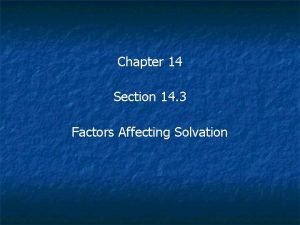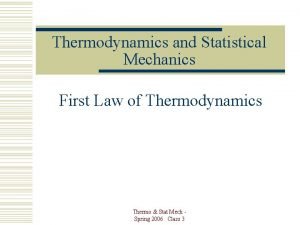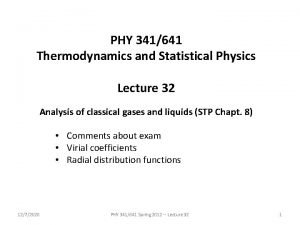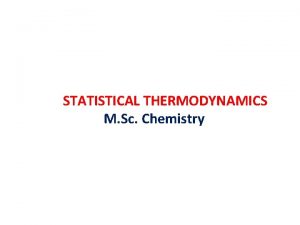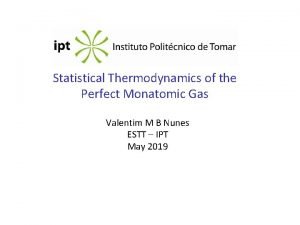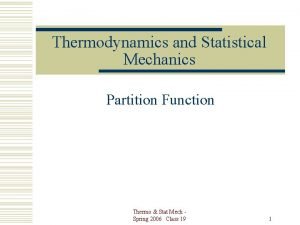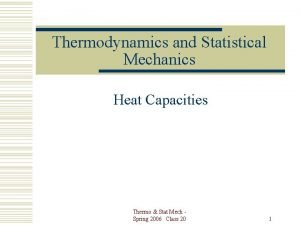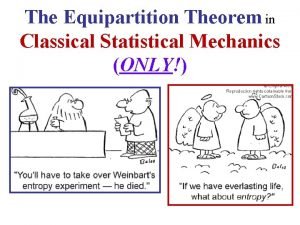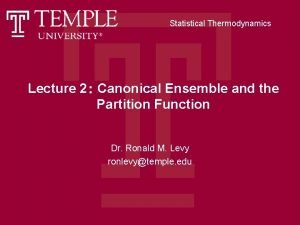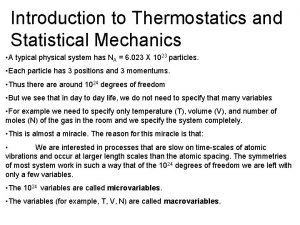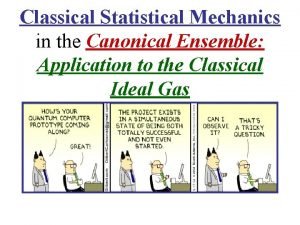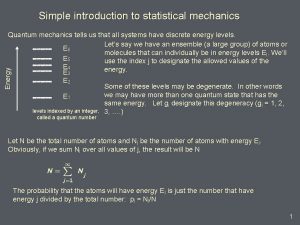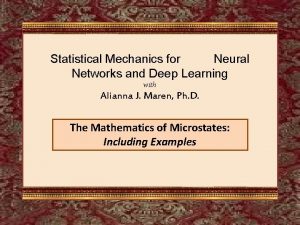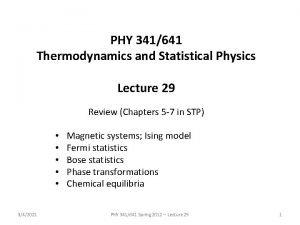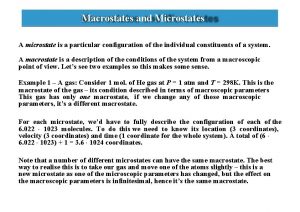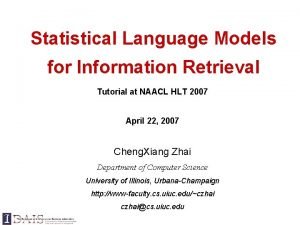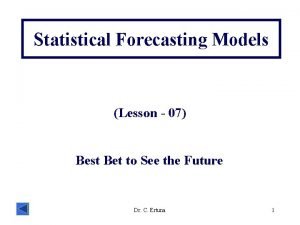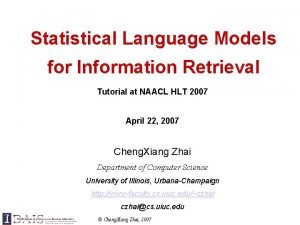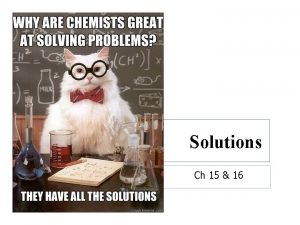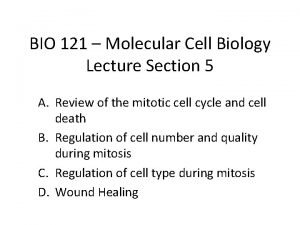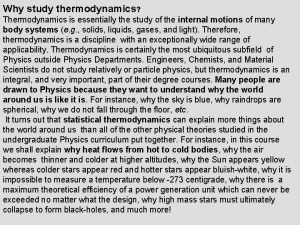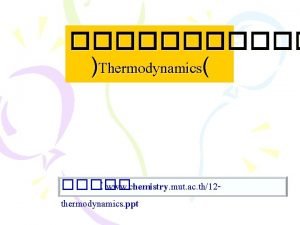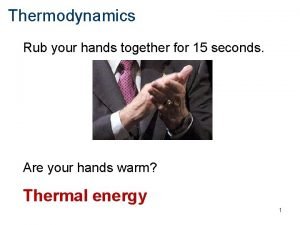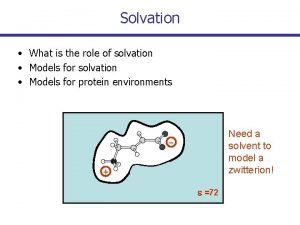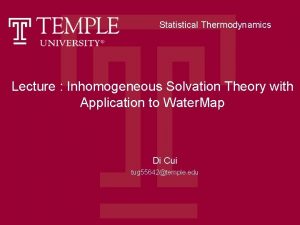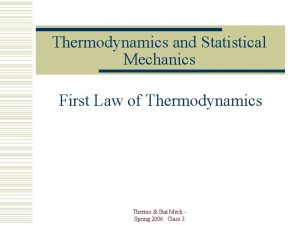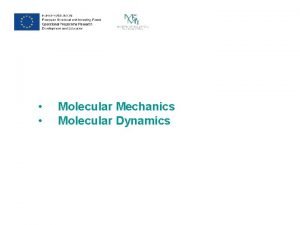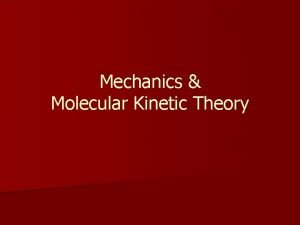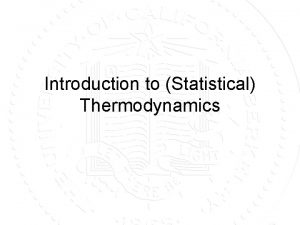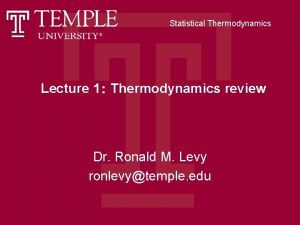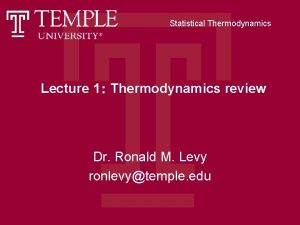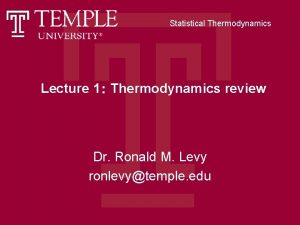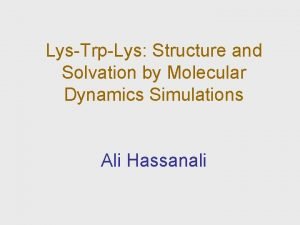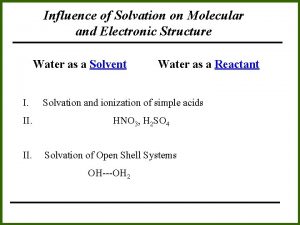Statistical Thermodynamics Lecture 12 Solvation Models Molecular Mechanics






























- Slides: 30

Statistical Thermodynamics Lecture 12: Solvation Models: Molecular Mechanics Modeling of Hydration Effects Dr. Ronald M. Levy ronlevy@temple. edu

“Bare” Molecular Mechanics Atomistic Force Fields: torsion stretching bending non-bonded

Hydration has a large effect on the conformations of macromolecules MD simulation, RMSD from native:

… and on ligand binding Distribution of complex decoy binding energies:

Challenge • Model hydration conveniently, as accurately as needed by the application and with the least computational cost. Two main approaches • Explicit solvation models. • Implicit solvation models.

Explicit Solvation • Each solvent molecule is represented with a set of atomic interaction centers (just as for the solute). • • Most accurate/detailed. Computationally expensive. Requires averaging over solvent coordinates. Difficult to obtain relative free energies of solute conformations.

Implicit Solvation • The solvent is represented by a continuum described by macroscopic parameters such as the dielectric constant, density, surface tension, etc. • Theoretical framework based on solvent PMF. • Not as accurate, especially for short-range solute-solvent interactions. • Reduced dimensionality. • Relative solvation free energies from single point effective potential energy calculations.

• • Many recent developments in molecular modeling have focused on solvation models. – Explicit: long-range electrostatic models – Implicit: improve coverage, accuracy and efficiency. Sometimes it is hard to keep track of all the choices. From a 2007 publication: The peptide is simulated in TIP 3 P and several variations of the GB implicit solvent model: GBHCT, GBOBC, and GBNeck (igb = 1, 5, and 7, respectively, in Amber 9). […] For consistency, MBondi radii were used in both the GB REMD simulations and subsequent GB and PE energy calculations described below. For TIP 3 P simulations, Ala 10 was solvated in a truncated octahedral box with 983 solvent molecules […] long-range electrostatic interactions were calculated using periodic boundary conditions via the particle mesh Ewald (PME). Roe, Wickstrom, et al. JPC B 111: 1846 (2007)

Explicit Hydration: Water Models • • • A water model specifies the interaction sites of a water molecule and their partial charges and LJ parameters. There is a large variety of models: rigid/flexible, 3 -points/4 -points or more, polarizable, dissociable, … The 3 rigid models most frequently used are SPC, TIP 3 P and TIP 4 P: SPC TIP 3 P TIP 4 P r(OH), Å 1. 0 0. 96 HOH, deg 109. 5 104. 5 σ(O), Å 3. 16 3. 15 ε(O), kcal/mol 0. 1554 0. 155 q(O) -0. 82 -0. 834 0. 0 q(H) 0. 417 0. 52 q(M) -1. 04

Periodic Boundary Conditions (PBC’s) • PBC’s are often used to simulate a bulk solution with a relatively small number of molecules. • The “central” simulation box is replicated in 3 D space so that the system has no edges. • The “minimum image convention” says that the actual distance between two particles is the smallest distance between all of the distances between their images: where L is the box size and x is the distance (along x) between any two images of a pair of particles. nint()=nearest integer. • A variety of space filling box shapes can be used. The “truncated octahedron” has particularly nice properties.

Treatment of long-range electrostatic interactions Electrostatic energy (per cell) of a periodic system: • The sum for the electrostatic potential φ includes all of the particles in the unit cell plus all of their images. • Straight sum is “conditionally convergent”; for example it would diverge if the positive and negative charges are summed separately. • Unlike LJ interactions, in this case truncation of the sum (with a distance cutoff) can be inaccurate. • In explicit solvent molecular simulation programs the infinite sum problem is circumvented using the “Ewald summation” class of models.

Ewald summation methods The Ewald sum is based on a decomposition of the 1/r interaction into a “fast decaying” component (handled with distance cutoffs) and a “smooth” component (summed using a Fourier transformation in reciprocal space). Think of surrounding each charge by a canceling Gaussian charge distribution: ρk is the Fourier transform of the charge distribution: measures the “softness” of the canceling distribution - the larger the more convergent is the direct sum (but less convergent is the reciprocal sum).

Particle mesh Ewald methods • Straightforward implementations of the Ewald sum scale at best as N 3/2 • More efficient implementations of complexity Nlog. N exploit FFT techniques by expressing the charge density on a regular grid. • The original idea of Hockeny and Eastwood (1981) consisted of assigning fractional charges to grid points: PPPM or P 3 M • Darden, York and Pedersen (1993) presented an (equivalent) approach based on Lagrange interpolation of the structure factors exp(ikr) on a grid: PME • PME was later refined using B-spline interpolation by Essmann et al. (1995) to obtain gradients for MD: SPME − In most recent papers, “PME” is SPME

Fast Multipole Methods • Based on representing distant charge distributions by multipole expansions. • Very favorable asymptotic scaling of order N – but with high initial overhead. • For values of N typical for biomolecular simulations FMM tends not to be as efficient as PME-based methods. • Still the only efficient method to treat longrange interactions without periodic boundary conditions. • Used routinely in simulations of million-body simulations of galaxies, etc. • A future for FMM in the context of implicit solvent modeling? Figuerido, Levy, Zhou, Berne. JCP 106: 9835 (1997)

Implicit Solvation: the solvent potential of mean force (SPMF) • Write the canonical partition function Qxy of the solution in terms of solute coordinates x, and solvent coordinates y. • The average of any observable that depends only on x can be written in terms of an “effective solvation potential” W(x). where defines the solvent potential of mean force • So called because the gradients of W(x) with respect to the solute coordinates are equal to the average forces of the solvent on the solute atoms at fixed solute conformation. • W(x) implicitly contains all of the effects of solvation.

The solvent potential of mean force is a free energy Conformational equilibria: x 2 x 1 Solvation (fixed solute conformation): y y x x

Polar/Non-polar decomposition of the solvent PMF

Typical Modern Implicit Solvent Model Electrostatic Component: Continuum Dielectric • Poisson-Boltzmann solvers (accurate but numerical and slow). • Generalized Born models (faster, can be expressed as analytic function). Non-Polar Component: • Solute surface area models • Cavity + van der Waals NP models.

The Poisson Equation (PE) and the Poisson-Boltzmann (PB) equations PE for a non-homogeneous dielectric: ε=1 ε= εslv Electrostatic free energy of solute: + - Electrostatic solvation free energy: direct Coulomb The reaction field potential φrf is due to the polarization of the medium.

The PB equation takes into account the effect of free ions in solution Debye-Hückel ion distribution - When (otherwise ion adsorption): ε=1 ε= εslv linearized form of the PB equation. where with (ionic strength). + +

Numerical solutions of the PB equation • The PB equation is solved on a grid in both surface and volume formulations. • Finite difference: solves the PB equation on a volume grid (APBS, Delphi, UHBD) • Finite element: solves integral form of the equation on a volume grid (PBF) • Boundary element: surface grid. • PB solvers often available in molecular simulation packages: Amber, CHARMM, IMPACT, etc. • Main drawback: continuum dielectric models are not suitable for specific short-range solute-solvent interactions, finite size effects, non-linear effects, high ionization states. • Other limitations are dependence on atomic radii parameters, speed, lack of analytical derivatives, dependence on frame of reference.

Approximate continuum dielectric models The basic idea is that a dielectric model of hydration should describe these two basic effects: 1. Dielectric polarization around polar groups • Favorable interaction between exposed charged atoms and the polarized dielectric. • Born model of ion hydration: - - 2. Dielectric screening of electrostatic interactions • The dielectric weakens the interactions between charges • Distance-dependent dielectric models - + + - - +

Generalized Born Model Bi is the Born radius of atom i defined by: • Satisfies the Born model in the two limits of infinite separation and complete overlap of solute atoms. • Basically it’s an interpolation formula.

Overall Features of Generalized Born Models The GB model “works” because it describes both dielectric polarization and dielectric screening effects. Polarization i=j (“self” energy): Favors the solvent exposure (small Bi) of polar groups (large q). Dielectric screening i≠j (pair energies):

Born Radii: Pairwise Descreening Scheme Born radius calculated as a sum of pairwise atomic contributions: Solute i Solvent Dielectric Summing over all j’s: j i i Qij: pairwise descreening function. Forms the basis for most analytical GB models used in molecular simulations.

Pairwise Descreening Gotchas Qij is not simply the integral of 1/|ri - r|4 over atom j because: 1. Overlaps with atom j and other atoms would be over-counted j i Reduce descreening contribution from atom j 2. Atoms i and j may overlap j i Integrate only over portion of j not overlapping with i 3. Both situations can and do occur simultaneously.

GB implementations • Most major biomolecular simulation packages (CHARMM, Amber, IMPACT, Gromacs, etc. ) include pairwise descreening GB implementations suitable for MD calculations. • Key ingredients are the atomic radii and the description of the solute volume. • The atoms overlap problem is generally addressed by empirical scaling coefficients parameterized with respect to higher level calculations – that is the geometric model is parameterized in addition to the energetic model (ACE, GB/SA, GBHCT, GBSW) • Work on the AGBNP series of models shows that “geometric” parameterization is unnecessary. • Some implementations (GBMV, SGB) perform numerical integration on a grid (volume or surface) – non-analytic, higher computational cost, difficulties with derivatives, dependence on coordinate frame. • Some implementations differ in the choice of the GB distance function f(r) • Many of the models include continuum dielectric “correction” terms. • Recent developments have focused on the “interstitial” volumes problem (GBneck, GBMV, AGBNP 2).

Non-Polar Hydration Free Energy • Defined as the work of introducing the “uncharged” solute into solution. • In some ways a harder problem for modeling than electrostatics. • Often (and, nearly as often, incorrectly) ignored because appears “small” in magnitude. • Traditionally modeled in terms of the solvent-exposed surface of the solute by means of a surface tension parameter (SA models) • Motivated by macroscopic interfacial models and theories of hydration of cavities (probability of spontaneous occurrence of voids) in water. • Recent developments have moved beyond surface-only models adopting distinct geometric models for the cavity and van der Waals components of non-polar hydration (NP models):

Example of an analytical NP model (the “NP” in AGBNP) : Surface area of atom i : Geometrical predictor based on Born radius : Surface tension and van der Waals adjustable parameters

Advantages of NP formulation • The free energy of cavity formation is defined by the solute geometry (by the surface area, say). • Van der Walls interactions are longer-ranged and also depend on the properties of individual atoms (C vs. O, say). • It makes sense to model these two components independently. PMF of dimerization of uncharged alanine dipeptide. Solute-solvent van der Waals energy changes upon binding. NP explicit solvent Non-monotonic behavior can not be reproduced with a surface area model. Large scatter relative to surface area model due to residual interactions of buried atoms.
 3 factors that affect solvation
3 factors that affect solvation Dulong petit law
Dulong petit law Thermodynamics and statistical mechanics
Thermodynamics and statistical mechanics Statistical thermodynamics is a study of
Statistical thermodynamics is a study of Statistical thermodynamics
Statistical thermodynamics Partition function in statistical mechanics
Partition function in statistical mechanics Statistical mechanics
Statistical mechanics Equipartition theorem statement
Equipartition theorem statement What is microcanonical ensemble
What is microcanonical ensemble Partition function in statistical mechanics
Partition function in statistical mechanics Partition function in statistical mechanics
Partition function in statistical mechanics Introduction to quantum statistical mechanics
Introduction to quantum statistical mechanics Statistical mechanics of deep learning
Statistical mechanics of deep learning Statistical mechanics
Statistical mechanics Macrostate and microstate
Macrostate and microstate Statistical language models for information retrieval
Statistical language models for information retrieval Statistical forecasting models
Statistical forecasting models Statistical language models for information retrieval
Statistical language models for information retrieval Henry's
Henry's How do intermolecular forces affect solvation?
How do intermolecular forces affect solvation? 01:640:244 lecture notes - lecture 15: plat, idah, farad
01:640:244 lecture notes - lecture 15: plat, idah, farad Molecular biology lecture
Molecular biology lecture Molecular cell biology lecture
Molecular cell biology lecture Cleavage
Cleavage What is a covalent bond simple definition
What is a covalent bond simple definition Giant molecular structure vs simple molecular structure
Giant molecular structure vs simple molecular structure Zinc oxide + nitric acid → zinc nitrate + water
Zinc oxide + nitric acid → zinc nitrate + water Semi modals
Semi modals Why do we study thermodynamics
Why do we study thermodynamics Thermodynamics ppt
Thermodynamics ppt Rubbing hands together energy
Rubbing hands together energy
